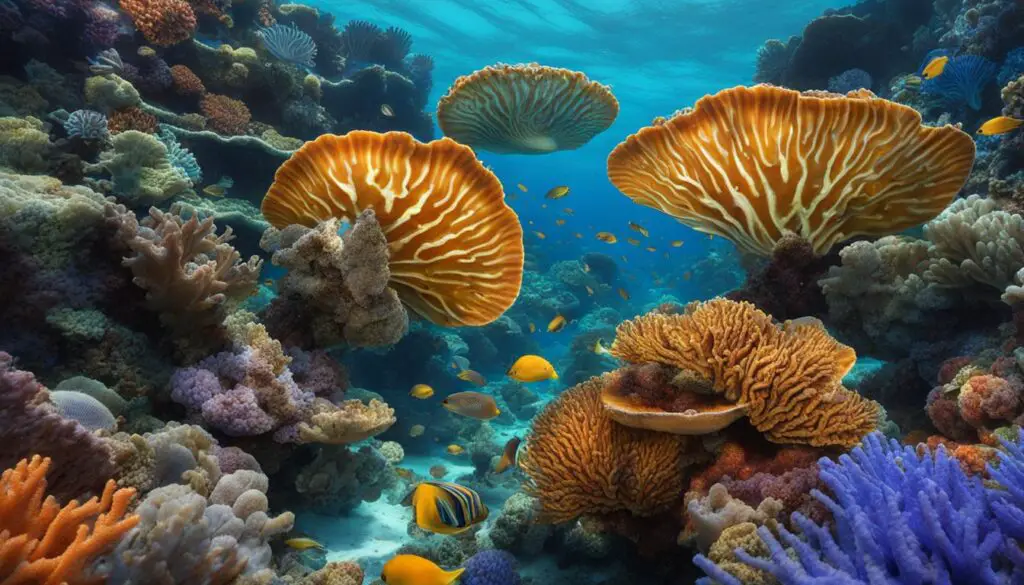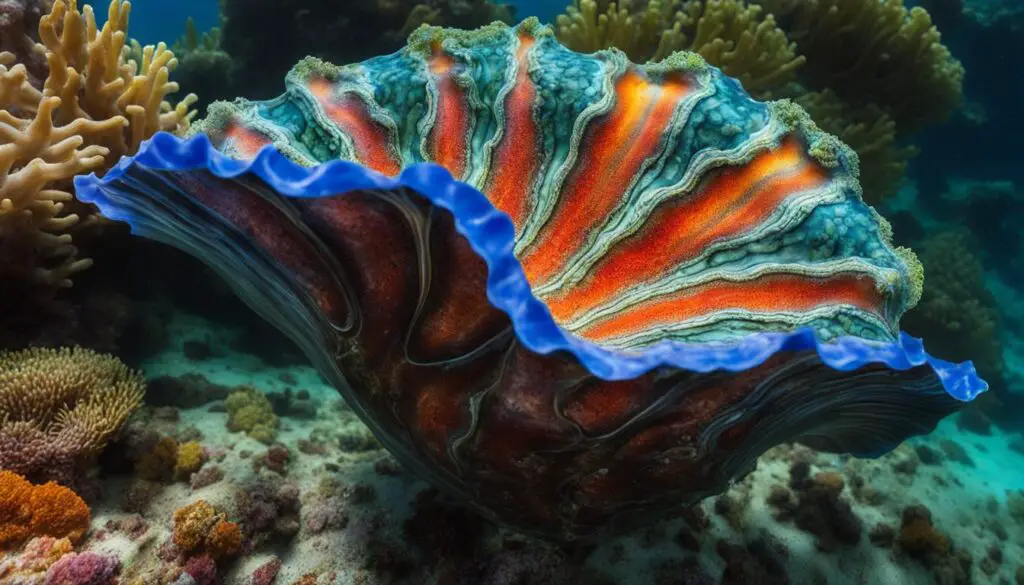Giant clams, with their impressive size and vibrant shells, inhabit the shallow waters of coral reefs and rocky coastlines. These remarkable mollusks, which can grow up to 4 feet in length and weigh over 400 pounds, prefer clear, warm waters with high sunlight exposure. They are found in various locations around the world, such as Indonesia, the Philippines, Papua New Guinea, Australia, and the Pacific Islands.
Conservation efforts are crucial to preserve the natural habitat of clams, as human activities like overfishing, pollution, and climate change have negatively impacted their population. Understanding the habitats and distribution of clams is vital for their preservation and the health of marine ecosystems.
Key Takeaways:
- Giant clams prefer shallow waters in coral reefs and rocky coastlines.
- They thrive in clear, warm waters with high sunlight exposure.
- Conservation efforts are crucial to protect their natural habitat.
- Human activities like overfishing, pollution, and climate change threaten clam populations.
- Understanding clam habitats and distribution is essential for preserving marine ecosystems.
Anatomy and Behavior of Giant Clams
Giant clams, with their impressive size and beautiful shells, possess unique anatomical features that set them apart from other mollusks. These fascinating creatures have a complex structure that enables them to thrive in their marine habitats.
At the heart of their anatomy are the two shells connected by a hinge, which are held together by powerful muscles. These shells serve as protection for the clam’s delicate inner organs. Inside, giant clams possess large muscular feet that allow them to anchor themselves to the ocean floor and facilitate movement when needed.
One of the most remarkable aspects of giant clams is their ability to filter feed. They use their gills to extract oxygen from the water and simultaneously filter tiny planktonic organisms and organic matter. This feeding method ensures their survival and sustains their growth. Additionally, giant clams have a sophisticated waste expulsion system through a siphon, which helps maintain their internal environment.
Behaviors and Adaptations
- Giant clams are filter feeders, extracting nutrients from the water.
- They have large muscular feet for anchoring and moving.
- Their shells provide protection for their inner organs.
- They possess gills for extracting oxygen from the water.
- They expel waste through a specialized siphon.
“The anatomical features of giant clams enable them to adapt and thrive in their marine habitats.”
A Symbiotic Relationship
Giant clams also have a fascinating symbiotic relationship with photosynthetic algae. These algae, known as zooxanthellae, reside within the clam’s tissue and harness sunlight to produce food through photosynthesis. In return, the clams provide the algae with a protected environment and necessary nutrients. This partnership allows the clams to supplement their filter feeding with energy-rich sugars produced by the algae, contributing to their overall survival and growth.
The unique anatomy and behavior of giant clams make them a captivating species to study. Their adaptations and symbiotic relationships shed light on the complex and interconnected nature of marine ecosystems.
Natural Habitat and Distribution of Giant Clams
Giant clams are fascinating creatures that thrive in specific natural habitats around the world. These magnificent mollusks can be found in the shallow waters of coral reefs and rocky coastlines. They have a preference for warm, clear waters with high sunlight exposure, which is essential for their symbiotic relationship with photosynthetic algae. Different species of giant clams have adapted to various environments and have distinct distributions.
For example, the Tridacna gigas, the largest species of giant clam, is primarily found in the Indian and Pacific Oceans. These impressive giants can weigh over 400 pounds and grow up to 4 feet in length. On the other hand, the Tridacna maxima, another species of giant clam, is mainly found in the Western and Central Pacific Oceans.
To preserve the natural habitat and ensure the survival of giant clams, it is essential to protect the coral reefs where they reside. These delicate ecosystems are threatened by various factors, including overfishing, pollution, climate change, ocean acidification, and rising sea temperatures. Conservation efforts, such as the establishment of marine protected areas and sustainable fishing practices, play a crucial role in safeguarding giant clam populations and the marine ecosystems they contribute to.
Factors Influencing Habitat Selection
Several factors influence the habitat selection of giant clams. One key factor is the availability of suitable substrate for attachment. Giant clams anchor themselves to the ocean floor using their large muscular feet and prefer substrates like coral reefs and rocky coastlines. These substrates provide stability and support for the clams.
Another important factor is water quality. Giant clams require warm, clear waters with high sunlight exposure to sustain their symbiotic relationship with photosynthetic algae. This relationship is crucial for the clams’ nutrition and overall well-being.
- The availability of food sources is also essential for giant clams. They are filter feeders and rely on filtering tiny planktonic organisms and organic matter from the water. Areas with abundant food supply are favored by these remarkable creatures.
- Giant clams also seek habitats that provide protection from predators. Their shells and anchoring mechanisms offer some defense, but they still benefit from habitats with minimal predator presence.
Understanding the natural habitat and distribution of giant clams is vital for their conservation and the preservation of marine ecosystems. By protecting their habitats and addressing the various threats they face, we can ensure that these incredible creatures continue to thrive and contribute to the diversity and health of our oceans.

Ecological Importance and Conservation of Giant Clams
Giant clams are not only fascinating creatures but also play a crucial role in the ecological balance of coral reefs. These magnificent mollusks contribute to the health and diversity of marine ecosystems in several ways:
- Water filtration: Giant clams act as natural filters, removing organic particles and pollutants from the surrounding water. By doing so, they help maintain water clarity and quality, creating a healthier environment for other organisms.
- Habitat creation: The large shells of giant clams provide shelter for various marine species, including small fish, crustaceans, and other invertebrates. These organisms seek refuge in the crevices and gaps of the clam shells, benefiting from the protective habitat they provide.
- Reef-building: Giant clams contribute to the growth and stability of coral reefs. They excrete calcium carbonate, which helps form the foundation of reef structures. Over time, their calcium carbonate deposits become part of the reef, enhancing its overall structure and resilience.
However, the conservation of giant clams is imperative due to the numerous threats they face. Overfishing, driven by the high demand for their meat, shells, and pearls, has significantly depleted their populations. Habitat destruction, pollution, and climate change also pose significant risks to their survival.
“Preserving the natural habitats of giant clams is not only important for their survival but also for the overall health and resilience of coral reefs,” says marine biologist Dr. Anna Simmons. “Giant clams play a vital role in maintaining the delicate balance of these ecosystems, and their decline could have far-reaching consequences.”
To ensure the conservation of giant clams and their habitats, various strategies can be implemented:
- Marine protected areas: Establishing protected zones where fishing and other harmful activities are restricted can help safeguard giant clam populations and their habitats.
- Sustainable fishing practices: Implementing regulations and guidelines for responsible harvesting can ensure that clam populations are not depleted beyond their ability to recover.
- Education and awareness: Promoting public awareness about the ecological importance of giant clams and the need for their conservation can garner support and encourage responsible behavior.
- Research and monitoring: Continued scientific research is essential to better understand the specific needs and requirements of giant clams. This knowledge can inform conservation efforts and facilitate the development of effective management strategies.
By prioritizing the conservation of giant clams and their habitats, we can protect these remarkable creatures and the invaluable contributions they make to marine ecosystems. Through collective efforts, we can ensure a sustainable future for giant clams and the preservation of our precious coral reefs.
Cultural Significance and Economic Value of Giant Clams
The Cultural Significance of Giant Clams
Giant clams hold immense cultural significance in many countries, particularly in the Pacific Islands. These magnificent creatures are woven into the fabric of traditional ceremonies, dances, and folklore, symbolizing the rich history and heritage of these communities. For generations, giant clams have been revered as icons of strength, prosperity, and natural beauty. Their vivid shells, ranging in colors from vibrant blues to majestic purples, have inspired awe and wonder in the hearts of those who behold them.
The Economic Value of Giant Clams
Giant clams also possess substantial economic value, driving local economies through their commercial harvest. These magnificent mollusks are sought after for their meat, shells, and pearls. Their tender and flavorful meat is a delicacy, highly prized in various culinary traditions. Additionally, their exquisite shells, with their intricate patterns and striking colors, are in demand for use in artisanal crafts, jewelry, and ornamental pieces. The pearls produced by some species of giant clams are rare and valuable gems, adorning jewelry collections with their lustrous beauty.
The Importance of Sustainable Practices
However, the cultural significance and economic value of giant clams are threatened by overfishing and habitat destruction. To ensure their long-term preservation and the continued benefit they bring to local communities, it is essential to adopt sustainable fishing practices and conservation measures. By establishing marine protected areas and implementing responsible harvesting techniques, we can strike a balance between cultural practices, economic opportunities, and the conservation of these remarkable creatures and their vital habitats.

Longevity and Research on Giant Clams
Research on giant clams has unveiled their remarkable lifespan, with some individuals living for over 500 years. These incredible creatures have unique adaptations that enable them to withstand low oxygen levels and thrive in their marine environments. Scientists are captivated by their longevity and are conducting extensive research to gain a deeper understanding of the aging process in various organisms, including humans.
Current studies focus on various aspects of giant clams, such as their reproductive processes, the intricate relationship between these clams and their photosynthetic algae partners, and techniques for captive breeding. By delving into the mysteries of giant clams, researchers hope to shed light on the secrets of aging and longevity. Moreover, ongoing efforts in conservation and research contribute to a positive future outlook for these fascinating creatures, ensuring that they may continue to flourish in their natural habitats for generations to come.
FAQ
How big can giant clams grow?
Giant clams can grow up to 4 feet in length and weigh over 400 pounds.
Where are giant clams found?
Giant clams are found in the shallow waters of coral reefs and rocky coastlines in various locations around the world, such as Indonesia, the Philippines, Papua New Guinea, Australia, and the Pacific Islands.
What is the role of giant clams in coral reefs?
Giant clams play a crucial role in maintaining the health and diversity of coral reefs. They filter water, provide a habitat for other marine organisms, and help keep the reef environment clean.
How are giant clams affected by human activities?
Human activities like overfishing, pollution, and climate change have negatively impacted the population of giant clams. Conservation efforts are needed to preserve their natural environment.
Do giant clams have any cultural significance?
Giant clams hold cultural significance in many countries, particularly in the Pacific Islands. They are used in traditional ceremonies, dances, and folklore.
How long do giant clams live?
Giant clams can live for over 500 years, making them one of the longest-lived organisms. Ongoing research focuses on their longevity and aging process.

